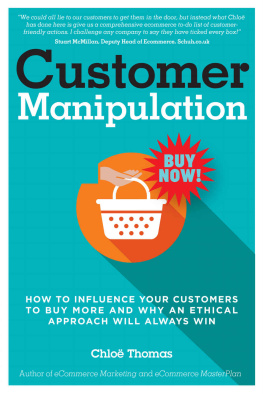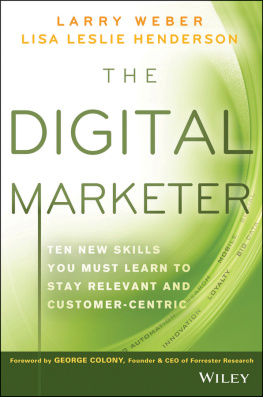UNLEASHING THE
IDEAVIRUS
by SETH GODIN
With a Foreword by Malcolm Gladwell
Stop marketing at people!
Turn your ideas into epidemics by helping
your customers do the marketing for you.

This book is dedicated to Alan Webber
and Jerry Colonna. Of course.
SNEEZE HERE!
Heres what you can do to spread the word about Unleashing the Ideavirus:
Send a friend to www.ideavirus.com so they can download the free manifesto.
Visit www.fastcompany.com/ideavirus to read the Fast Company article.
Buy a copy of the hardcover book for a friend online.
Get a free copy for your Palm at www.peanutpress.com.
The #1 question people ask me after reading
Permission Marketing:
So, how do we get attention to ask for permission in the
first place?
This manifesto is the answer to that question.
CONTENTS
T he notion that an idea can become contagious, in precisely the same way that a virus does, is at once common-sensical and deeply counter-intuitive. It is common-sensical because all of us have seen it happen: all of us have had a hit song lodged in our heads, or run out to buy a book, or become infected with a particular idea without really knowing why. It is counter-intuitive, though, because it doesnt fit with the marketers traditional vision of the world. Advertisers spent the better part of the 20th century trying to control and measure and manipulate the spread of informationto count the number of eyes and ears that they could reach with a single message. But this notion says that the most successful ideas are those that spread and grow because of the customers relationship to other customersnot the marketers to the customer.
For years, this contradiction lay unresolved at the heart of American marketing. No longer. Seth Godin has set out to apply our intuitive understanding of the contagious power of informationof what he so aptly calls the ideavirusto the art of successful communication. Unleashing the Ideavirus is a book of powerful and practical advice for businesses.
But more than that, it is a subversive book. It says that the marketer is notand ought not to beat the center of successful marketing. The customer should be. Are you ready for that?
M ALCOLM G LADWELL
Author of The Tipping Point
www.gladwell.com
I f you dont have time to read the whole book, heres what it says:
Marketing by interrupting people isnt cost-effective anymore. You cant afford to seek out people and send them unwanted marketing messages, in large groups, and hope that some will send you money.
Instead, the future belongs to marketers who establish a foundation and process where interested people can market to each other. Ignite consumer networks and then get out of the way and let them talk.
If youre looking for mindblowing new ideas, you wont find them in this, or any other marketing book. Guerrilla marketing, 1:1 marketing, permission marketingthese ideas are not really new, but they are thoughtful constructs that let you figure out how to do marketing better. The fact is, if we built factories as badly as we create advertising campaigns, the country would be in a shambles. This book will help you better understand the time-honored marketing tradition of the ideavirus, and help you launch your own.
Questions this book answers:
Why is it foolish to launch a new business with millions of dollars in TV ads?
Are the market leaders in every industry more vulnerable to sudden successes by the competition than ever before?
Should book publishers issue the paperback edition of a book before the hardcover?
Whats the single most important asset a company can createand what is the simple thing that can kill it?
Every ad needs to do one of two things to succeed yet most ads do neither. Whats the right strategy?
Does the Net create a dynamic that fundamentally changes the way everything is marketed?
How can every business big and small use ideavirus marketing to succeed?
SECTION 1
WHY IDEAS MATTER
I magine for a second that youre at your business school reunion, trading lies and bragging about how successful you are and/or are about to become. Frank the jock talks about the dot-com company he just started. Suzie the ex-banker is now focusing her energy on rebuilding Eastern Europe. And then the group looks at you. With a wry look of amusement, you answer:
Well, the futurethe really big moneyis in owning a farm. A small one, maybe 100 acres. I intend to invest in a tractor of course, and expect that in just a few years my husband and I can cash out and buy ourselves a nice little brownstone in the city.
Ludicrous, no? While owning a farm may bring tremendous lifestyle benefits, it hasnt been a ticket to wealth for, say, 200 years.
What about owning a factory then? Perhaps the road to riches in the new economy would be to buy yourself a hot-stamping press and start turning out steel widgets. Get the UAW to organize your small, dedicated staff of craftsmen and youre on your way to robber-baron status.
Most of us can agree that the big money went out of owning a factory about thirty years ago. When youve got high fixed costs and youre competing against other folks who also know how to produce both quantity and quality, unseemly profits fly right out the window.
Fact is, the first 100 years of our countrys history were about who could build the biggest, most efficient farm. And the second century focused on the race to build factories. Welcome to the third century, folks. The third century is about ideas.
Alas, nobody has a clue how to build a farm for ideas, or even a factory for ideas. We recognize that ideas are driving the economy, ideas are making people rich and most important, ideas are changing the world. Even though were clueless about how to best organize the production of ideas, one thing is clear: if you can get people to accept and embrace and adore and cherish your ideas, you win. You win financially, you gain power and you change the world in which we live.
So how do you win? What do you need to do to change the status quo of whatever industry youre in, or, if youre lucky, to change the world?
If youre a farmer, you want nothing more than a high price for your soybeans. If youre a manufacturer of consumer goods, you want a display at the cash register at Wal-Mart. But what if youre an idea merchant?
The holy grail for anyone who traffics in ideas is this: to unleash an ideavirus.
An idea that just sits there is worthless. But an idea that moves and grows and infects everyone it touches thats an ideavirus.
In the old days, there was a limit on how many people you could feed with the corn from your farm or the widgets from your factory. But ideas not only replicate easily and well, they get more powerful and more valuable as you deliver them to more people.
How does an ideavirus manifest itself? Where does it live? What does it look like? Its useful to think of ideas of every sort as being similar. I call them manifestos. An idea manifesto is a powerful, logical essay that assembles a bunch of existing ideas and creates a new one. Sometimes a manifesto is a written essay. But it can be an image, a song, a cool product or process the medium doesnt matter. The message does. By lumping all sorts of ideasregardless of formatinto the same category (manifestos) its much easier to think of them as versions of the same thing. As long as you can use your manifesto to change the way people think, talk or act you can create value.

















